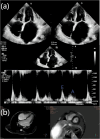Case Report: Restrictive cardiomyopathy due to a rare mutation in troponin I gene (TNNI3) in a patient
- PMID: 39635265
- PMCID: PMC11614833
- DOI: 10.3389/fcvm.2024.1456542
Case Report: Restrictive cardiomyopathy due to a rare mutation in troponin I gene (TNNI3) in a patient
Abstract
Background: Restrictive cardiomyopathy (RCM) is a rare cardiomyopathy often characterized by normal or reduced ventricular chamber volume and bi-atrial enlargement, caused mainly by mutations in the myonodal gene. It has a low incidence, non-specific clinical manifestations, rapid progression, and lack of specific treatment, with heart transplantation usually being the ultimate treatment.
Methods and results: This case reports a case of a 2-year-2-month-old boy located in Yunnan Province, China, who was admitted to the hospital with a 2-month history of orofacial bruising, aggravated by a 1-week history of bilateral eyelid swelling. After admission, electrocardiogram showed bi-atrial enlargement, echocardiography suggested bi-atrial enlargement with right and left ventricular diastolic hypoplasia, and cardiac magnetic resonance showed bi-atrial dilatation and possible localized myocardial fibrosis. A de novo heterozygous mutation (c.574C > T, p.Arg192Cys) in the TNNI3 gene was identified by whole exome sequencing and verified by Sanger sequencing. The patient's family opted for conservative treatment after diagnosis, but the patient died suddenly 2 months after diagnosis.
Conclusion: This study identified a case of RCM due to TNNI3 mutation, emphasizing the importance of cardiac MRI and genetic testing in the clinical diagnosis of RCM and the need for heart transplantation. The study also revealed the possible heterogeneity of TNNI3 mutations across ethnic and geographic backgrounds, suggesting that long-term studies of genetic mutations should be strengthened in the future to promote the development of precision treatment strategies for cardiomyopathy.
Keywords: TNNI3gene; case; children; mutation; restrictive cardiomyopathy.
© 2024 Deng, Luo, Zhang, Guo and Liu.
Conflict of interest statement
The authors declare that the research was conducted in the absence of any commercial or financial relationships that could be construed as a potential conflict of interest.
Figures



Similar articles
-
[Genetic analysis of a child with restricted cardiomyopathy and phenylketonuria and a literature review].Zhonghua Yi Xue Yi Chuan Xue Za Zhi. 2023 Aug 10;40(8):990-997. doi: 10.3760/cma.j.cn511374-202200909-00615. Zhonghua Yi Xue Yi Chuan Xue Za Zhi. 2023. PMID: 37532500 Review. Chinese.
-
Pediatric restrictive cardiomyopathy: a case report.J Int Med Res. 2023 Aug;51(8):3000605231188276. doi: 10.1177/03000605231188276. J Int Med Res. 2023. PMID: 37646638 Free PMC article.
-
Diagnostic disparity and identification of two TNNI3 gene mutations, one novel and one arising de novo, in South African patients with restrictive cardiomyopathy and focal ventricular hypertrophy.Cardiovasc J Afr. 2015 Mar-Apr;26(2):63-9. doi: 10.5830/CVJA-2015-019. Cardiovasc J Afr. 2015. PMID: 25940119 Free PMC article.
-
Challenging of ECMO application in pediatric restrictive cardiomyopathy: case report of a novel TNNI3 variant.Front Cardiovasc Med. 2024 May 24;11:1365209. doi: 10.3389/fcvm.2024.1365209. eCollection 2024. Front Cardiovasc Med. 2024. PMID: 38854656 Free PMC article.
-
Restrictive cardiomyopathy: from genetics and clinical overview to animal modeling.Rev Cardiovasc Med. 2022 Mar 17;23(3):108. doi: 10.31083/j.rcm2303108. Rev Cardiovasc Med. 2022. PMID: 35345275 Review.
References
-
- Caleshu C, Sakhuja R, Nussbaum RL, Schiller NB, Ursell PC, Eng C, et al. Furthering the link between the sarcomere and primary cardiomyopathies: restrictive cardiomyopathy associated with multiple mutations in genes previously associated with hypertrophic or dilated cardiomyopathy. Am J Med Genet A. (2011) 155A(9):2229–35. - PMC - PubMed
Publication types
LinkOut - more resources
Full Text Sources
Research Materials

